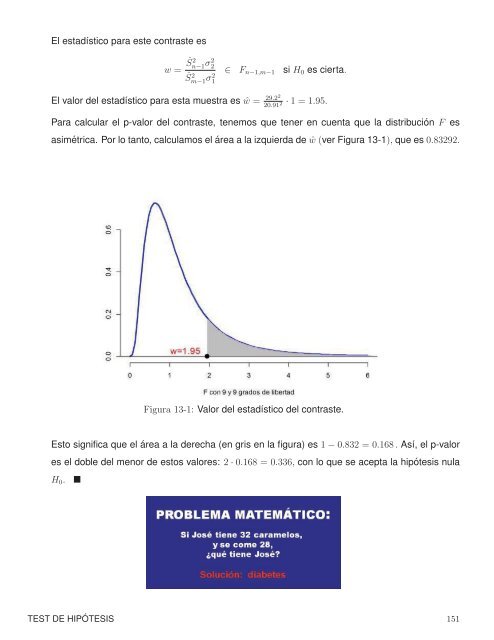- Page 3 and 4:
Problemas Estimulantes de Probabili
- Page 7 and 8:
5 Intervalos de confianza. 375.1 In
- Page 9 and 10:
6 Prólogo
- Page 14 and 15:
1. PROBABILIDADPara introducir la n
- Page 16 and 17:
d) P (Ā ∩ ¯B) =P (A ∪ B) =1
- Page 18 and 19:
= P (A 1 )P (A 2 /A 1 )P (A 3 /A 1
- Page 20 and 21:
- ∪ n i=1A i =Ωy además son tal
- Page 22 and 23:
2. VARIABLES ALEATORIASEn ocasiones
- Page 24 and 25:
2.2 Variables aleatorias continuasU
- Page 26 and 27:
3. PRINCIPALES VARIABLES DISCRETAS3
- Page 28 and 29:
forma independiente y con media est
- Page 30 and 31:
distribución Binomial Negativa de
- Page 32 and 33:
Ejemplo. Según un estudio propio r
- Page 34 and 35:
4. PRINCIPALES VARIABLES CONTINUAS4
- Page 36 and 37:
4.3 Variable ExponencialUna variabl
- Page 38 and 39:
p =P(reserva vacía)=0.14.El avión
- Page 40 and 41:
5. INTERVALOS DE CONFIANZA.Un inter
- Page 42 and 43:
5.2 Intervalos para la comparación
- Page 44 and 45:
6. CONTRASTES DE HIPÓTESIS.Una hip
- Page 46 and 47:
4.-) Concluir si la diferencia ŵ e
- Page 48 and 49:
Figura 6-1: p-valor en un contraste
- Page 50 and 51:
Figura 6-4: p-valor en un contraste
- Page 52:
Parte IIEjercicios49
- Page 57 and 58:
P (matar a alguien) =P (hacer blanc
- Page 59 and 60:
Solución.Definimos los sucesos: C=
- Page 61 and 62:
8. En el armario de una choni hay c
- Page 63 and 64:
12. Como dicen los gallegos, las br
- Page 65 and 66:
Nos piden P (A 1 /D). Por la regla
- Page 67 and 68:
que aparezca de una vez el asesino
- Page 69 and 70:
∪ (V ∩ V ) ∪ (V ∩ O) ∪ (H
- Page 71 and 72:
Tenemos que P (P/H)=0.18,P(P/M)=0.0
- Page 73 and 74:
c)= P (A 1 )P (Ā2)P (Ā3)+P (Ā1)P
- Page 75 and 76:
La función de distribución es, po
- Page 77 and 78:
de pacientes que obtienen alivio. a
- Page 79 and 80:
distribución F :⎧0 si x1) = 1
- Page 81 and 82:
7. Un científico nuclear que ha lo
- Page 83 and 84:
9. Se lleva a cabo un estudio compa
- Page 85 and 86:
Definimos la variable X=“piso en
- Page 87 and 88:
· P (X =5)=P (extraer 1 sucio) =P
- Page 89 and 90:
86 VARIABLES DISCRETAS
- Page 91 and 92:
La gráfica de la función de distr
- Page 93 and 94:
Para calcular la desviación típic
- Page 95 and 96:
Solución.La función de distribuci
- Page 97 and 98:
Solución.Llamemos D a la variable
- Page 99 and 100:
9. Un bombardero inteligente lleva
- Page 101 and 102:
E(Y 3 )=∫ 10y 3 2ydy = 2 5 ; E(Y
- Page 103 and 104: ) Primero vamos a calcular k 1 y k
- Page 105 and 106: 15. El tiempo transcurrido (en año
- Page 107 and 108: 104 VARIABLES CONTINUAS.
- Page 109 and 110: 3. De un grupo de 20 alumnos de la
- Page 111 and 112: 6. La madame de una casa de citas q
- Page 113 and 114: 9. En Villapodre del chorizo de aba
- Page 115 and 116: De 35 personas, hay 17 hombres de c
- Page 117 and 118: 15. Los Vengadores están esperando
- Page 119 and 120: 500La variable X=“número de taco
- Page 121 and 122: 22. Rivaldillo, un famoso crack de
- Page 123 and 124: 25. En una caja de preservativos ha
- Page 125 and 126: Poisson Pois(50 · 0.048=2. 4). La
- Page 127 and 128: 3. En un ayuntamiento se ha calcula
- Page 129 and 130: que el dueño del Tablet no tenga q
- Page 131 and 132: La variable X=“número de curacio
- Page 133 and 134: = F N(0,1) (−0.6) · 0.2=0.30765.
- Page 135 and 136: 12. El programa “Crónicas marran
- Page 137 and 138: c) X 1 − X 2 ∈ N(0, √ 10 2 +(
- Page 139 and 140: 2. En una encuesta del Centro de In
- Page 141 and 142: 5. La desviación típica de la can
- Page 143 and 144: 7. El diario “El imparcial de der
- Page 145 and 146: El intervalo para Rubalcabra es(√
- Page 147 and 148: Si se supone que el muestreo se lle
- Page 149 and 150: Si el error máximo admitido para l
- Page 151 and 152: 148 INTERVALOS DE CONFIANZA
- Page 153: 2. El dueño del bar (habitualmente
- Page 157 and 158: Figura 13-2: Valor del estadístico
- Page 159 and 160: ⇔ 73 − μ = −2.92Ŝn−1 √
- Page 161 and 162: El p-valor del contraste es 0.12 (2
- Page 163 and 164: El p-valor es el área a la izquier
- Page 165 and 166: ) Suponemos n 1 = n 2 .El intervalo
- Page 167 and 168: Se trata de contrastar H 0 : μ =8f
- Page 169 and 170: y el valor del estadístico del con
- Page 171 and 172: (grupo 1) y otros que ven “2001 o


